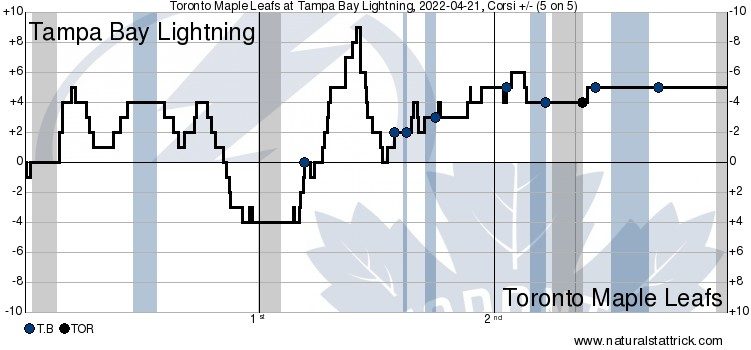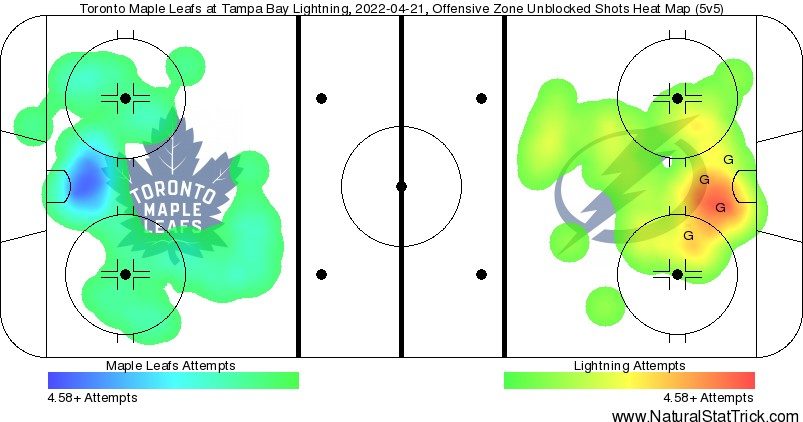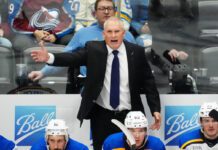In a potential playoff preview, the Tampa Bay Lightning pummeled the Toronto Maple Leafs 8-1 tonight at Amalie Arena, taking advantage of a Leafs team without Auston Matthews by pouring it on in a game defined by brutish physicality and unruliness.
After a scoreless opening period, the Lightning struck four times against Erik Källgren in the second frame and didn’t stop there, putting up four more in the third. They converted five times on different varieties of power plays — including two goals each from Alex Killorn and Ross Colton as well as a record-breaking tally from Steven Stamkos — to light up the Maple Leafs. Ilya Mikheyev broke the shutout, but it was one of the only bright spots for Toronto.
The game also featured numerous fights, most notably between Wayne Simmonds and Patrick Maroon, and devolved into perpetual chippy shoving matches by the end. The two teams combined for 116 PIM by the time it was all said and done, and the Lightning walked away with the two points.
Your game in 10:
1. The vibes for this game were not particularly great going in from a Leafs perspective, from the decision to start Erik Källgren in net, to the scratching of Auston Matthews who practiced with the team (and looked good, according to witnesses), to the fact the Lightning were coming off an embarrassing home loss to the Red Wings. It felt like the Leafs were going to have to claw harder than normal to win this game, but the first period ended with no goals either way.
The Leafs generated several chances in the opening stanza and so did the Lightning, but the two respective goalies stood tall. An abundance of rush chances were the storyline in the first period, and I thought Källgren looked quite good in that first period.
This was a nice stop on a 2v1 rush for Tampa:
Kallgren is in position to make the stop #LeafsForever pic.twitter.com/pkUhFKyR1G
— Maple Leafs Hotstove (@LeafsNews) April 22, 2022
The best chance for the Leafs in the first period might’ve come short-handed when Mitch Marner slipped a pass to Mark Giordano, who was poke-checked by Andrei Vasilevskiy:
Marner with a great pass to Giordano for a look SH #LeafsForever pic.twitter.com/cmh0LSWO8R
— Maple Leafs Hotstove (@LeafsNews) April 22, 2022
The Leafs ended the first period outshooting the Lightning, but the Lightning won the xG and scoring chance battle.
2. Something evident right from the beginning of the game was that the Lightning appeared to have a lot of jump in their step, especially on the forecheck. The Tampa forecheckers were hitting the Toronto defensive zone with aggression, pressuring every zone exit and causing the Leafs headaches. Sheldon Keefe mentioned the problem of clean exits in his interview with the ESPN crew before the start of the second period; it was an issue that persisted throughout the night.
As the second period got going, the Lightning seemed to have more energy and looked faster, which was a stark departure from the last meeting, when the Leafs torched the Bolts’ hulking defensemen with their speed. Given the heavy nature of the Lightning lineup — not to mention their age and the amount of hockey the team has played in the last two calendar years — if the Leafs are not the faster team in a matchup between these two teams, they are in big trouble.
The Lightning appeared faster and more energized — as though they had more to play for (which, given their playoff positioning battle with Boston, they do) — and that was an ominous sign in the early going.
It wouldn’t take long for the foreboding feeling to turn into a lightning storm.
3. The Leafs entered the second period with a power play, but they didn’t create much on it. Not long afterward, the Bolts scored.
The Leafs lost a defensive zone draw after John Tavares was kicked out of the dot and the Lightning began to cycle the puck around the perimeter. It reached the point, where a shot from Cal Foote was deflected in by the stick of Alex Killorn to make it 1-0:
Killorn gets a piece of the shot. 1-0 Lightning #LeafsForever pic.twitter.com/6d5NqRpoYx
— Maple Leafs Hotstove (@LeafsNews) April 22, 2022
It was one of several times tonight that the energy gap between the two clubs reared its head, with the Lightning hemming in the Leafs far too often. Their intensity in the slot and around the net allowed Killorn to gain positioning for the deflection.
4. The goal was a shot of confidence for the Lightning, whose play only seemed to rachet up a notch after the first one went in. Andrei Vasilevskiy remained completely dialed in, stopping Michael Bunting‘s scoring chance before the Lightning struck again after their forecheck pressured the Toronto defense.
Nick Paul’s aggressive forecheck tracked Morgan Rielly down, causing him to fall (no whistle) before Paul took it to the net and made the pass across to Ross Colton for the tap-in goal:
Colton on the doorstep buries it. 2-0 Lightning #LeafsForever pic.twitter.com/0T71xXYoOU
— Maple Leafs Hotstove (@LeafsNews) April 22, 2022
Ideally, one of Timothy Liljegren or Colin Blackwell would’ve taken the pass away there, but the play began with Rielly turning the puck over. It was definitely close to a tripping penalty, but no whistle came. The questionable nature of the takedown makes the play a little fuzzy to be totally emblematic of the Lightning’s success on the forecheck in pressuring Toronto’s D, but it is not a terrible example, either.
I thought that Ilya Lyubushkin may have struggled the most against the Tampa offensive-zone forecheck (something I speculated about a couple of nights ago), but this was a problem that infected the entire team.
The Lightning have not looked as hungry or as fast in recent weeks, but this was a wake-up call effort from the 2x defending champions, who were puck hounds on the boards and took away the Leafs’ time and space.
5. By this point, the Leafs were already in a precarious situation, but that’s before the Lightning had really gotten a chance to inflict their damage on the power play. Jason Spezza was called for a questionable penalty — it seemed to be more of a reaction to Pierre Edouard Bellemare taking a shot off the leg than anything else — and the Lightning went to the man advantage. It didn’t take long:
Stamkos cashes in on the man advantage. 3-0 Lightning #LeafsForever pic.twitter.com/OmhsxJlHYn
— Maple Leafs Hotstove (@LeafsNews) April 22, 2022
Toronto left far too much room to pass across the seam for Nikita Kucherov — who is perhaps the best in the NHL at making that pass — and Stamkos ripped the shot by Erik Källgren. With that goal, Stamkos became the all-time points leader in Tampa Bay Lightning franchise history, passing the great Martin St. Louis.
The Lightning weren’t done, though, and headed to another PP only a few minutes later after Ilya Lyubushkin was called for a high-sticking penalty. Before the Lightning scored on the PP, there was a play that takes the cake for the best encapsulation of the energy imbalance tonight:
Marner was tripped up but not called #LeafsForever pic.twitter.com/699kr0vBvh
— Maple Leafs Hotstove (@LeafsNews) April 22, 2022
Regardless of whether this should be a penalty or not, the fact that Steven Stamkos hustled all the way back to nullify Mitch Marner‘s shorthanded rush says a lot about Tampa’s intensity in this game. Marner is not a player who gets tracked down from behind often, let alone by a 32-year-old who is no one’s idea of the fastest player in the NHL. After Stamkos took the puck away and Corey Perry led a rush in the other direction, Källgren made the first stop but gave up a poor rebound that Nikita Kucherov finished it off.
By this point, the destination of the two points was not in question.
6. Before the second period was up, the physicality began to ramp up and tempers started to flare as well. Anthony Cirelli and Mark Giordano engaged in some pushing and shoving, leading to Giordano landing a couple of blows:
Tempers flare after the whistle #LeafsForever pic.twitter.com/33IhOfeVzh
— Maple Leafs Hotstove (@LeafsNews) April 22, 2022
John Tavares and Brandon Hagel were tangled up as well, and most viewers could sense that the final 24 minutes were going to get pretty ugly. The first true fight unfolded not long after between Wayne Simmonds and Pat Maroon, who had been chirping at each other all night long, with many of Maroon’s barbs caught on the hot mic:
Simmonds and Maroon drop the gloves #LeafsForever pic.twitter.com/RUButRjQBS
— Maple Leafs Hotstove (@LeafsNews) April 22, 2022
By the end of the second period, you would be excused if you opted to turn off the television. The Lightning were going to win this game, and it was going to be a long and messy third period.
7. Periods like tonight’s third are hard to glean much from; it is more about emotion, ego, and gamesmanship than hockey. The narrative of the game was already established, and the Lightning were going to win because they brought more energy and intensity as well as the better goalie (while the Leafs were missing their MVP).
Not much new was going to be learned in the third period, and I wouldn’t read much of anything into what actually happened on the ice. It was a near-constant cycle of power plays and game misconducts.
If there’s one thing to take away from the third, it is the interesting decision by the Lightning and coach Jon Cooper to continue to run up the score, something that MLHS’ own Anthony Petrielli mused about on Twitter:
I mean, to each their own and I get the argument the other way, but if I'm likely playing a team in round 1 in a few weeks, they are missing their best player and they have an AHLer in net, I'm probably not doing things like going full out to run them up, rolling PP1, etc.
— Anthony Petrielli (@APetrielli) April 22, 2022
Run up the score, they did. Just over a minute into the period, Ondrej Palat tipped in a point shot by Mikhail Sergachev to beat Erik Källgren and put the Lightning up 5-0.
That was the final goal in the game scored at 5v5, and most all of the final 18 minutes or so were played at either a reduced strength or with someone on the power play due to penalty after penalty.
8. The Lightning added two more on the PP and another at 4v4, while the Leafs finally broke the shutout on the PP before it was over. Of those four goals, the most memorable were probably the next Lightning tally and then the lone Leafs goal.
As for the Lightning, they got their sixth goal on a truly absurd pass from Victor Hedman at the point, no-look backhand to Nikita Kucherov on the wing, who ripped a bullet that Alex Killorn easily tipped in at the net front.
For the Leafs fans who want to play Tampa in round one, tonight was a good reminder of the bonkers-level skill that the Lightning can bring to the game with some of the best passers and shooters in the league.
The Leafs finally got on the board with just over 12 minutes to go in the game, as a great pass from Jason Spezza on the power play connected with Ilya Mikheyev, who powered it by Andrei Vasilevskiy to break the ice:
Mikheyev ends the shutout bid. 6-1 #LeafsForever pic.twitter.com/m4Grg7uaW6
— Maple Leafs Hotstove (@LeafsNews) April 22, 2022
That was Mikheyev’s 19th goal of the season, continuing to add on to his career-high, while Spezza collected point number 993 in his illustrious career, just seven away from the milestone 1,000.
Tampa’s final two goals were scored by Ross Colton and Pat Maroon, but perhaps more interesting were all the penalties. Kyle Clifford was hit with a 10-minute gross misconduct penalty for bonking Corey Perry on the head with his stick during a scrum, Maroon and Wayne Simmonds got matching misconducts for instigating, Alex Kerfoot fought Cal Foote (battle of the feet!), and Michael Bunting and Nick Paul both picked up their own misconducts at different points in the third period.
By the end, the game was a slog, with mini-scrums breaking out after every whistle and players getting sent off just for jawing. It was an ugly scene, but it was pretty clear how it went down. Tampa came in and rocked Toronto, both on the scoresheet and with their bodies, and the Leafs refused to let themselves get pushed around. By the time the final horn sounded, a statement had been made from both sides.
9. Before I conclude with some final thoughts on how to assess games like this one, let’s talk about Erik Källgren. Though Tampa was clearly the better team in my eyes, the expected goals battle was quite a bit closer (4.43-3.71 Tampa), and the blame for the lopsided score falls on Källgren analytically. Evolving Hockey hit him with -3.57 goals saved above expected, and a .778 save percentage never looks good. Was he actually that bad?
I don’t think so, but he also wasn’t exactly good. Källgren made some big-time stops in the first period, but once the floodgates opened, he seemed to drown. The fourth goal on the Kucherov rebound was not great, as Källgren was square to Perry and the shot came into his chest. No rebound should’ve been given up, and if one is, Källgren can’t be swimming and leaving the net exposed.
Similarly, I thought the Palat deflection goal was rather weak, as Källgren tried to glove it rather than positioning his body to stop the point shot, which would’ve absorbed the puck even after the deflection.
The rest of the goals weren’t really on him, in my eyes. The Stamkos blast is mighty tough to stop, the first Colton goal and the Killorn deflection were lightning-quick tap-ins, and the last two were also off passes.
In other circumstances, Källgren would’ve likely been yanked by the time those two goals were going in, but late in the season, Sheldon Keefe was not inserting Jack Campbell into this game. Källgren was dealt a tough hand, playing in front of a team that only owned 40.74% of the scoring chances, and perhaps things play out a little differently if Andrei Vasilevskiy had cracked earlier. Instead, it was a matchup of a third-string goalie having a rough game against a Vezina winner having a great game.
10. So what do we make of a game like this? The Leafs were pounded into the sand by the team they are more likely than not going to face in the first round of the playoffs. Reason for panic? Is the sky falling?
I think pretty clearly not. As I said off the top, this was not a game I was expecting the Maple Leafs to win coming in given the absence of Matthews and the decision to start Källgren. That it got ugly was unfortunate, but sometimes energy levels don’t line up. The Leafs don’t have a ton to play for as they close in on home ice in the first round while Tampa entered tonight only one point up on Boston for third in the Atlantic.
Moreover, the Leafs rode in feeling good and playing great hockey, while the Lightning came in on the heels of a six-week stretch of poor play and only two nights removed from losing to Detroit, who were without their best player (Dylan Larkin). If we needed a cherry on top of the other evidence, the last time these two clubs met, the Leafs embarrassed the Lightning in their home building and chased Andrei Vasilevskiy from the game. Tampa had a lot of reason to be furious and play with their hair on fire. They did just that.
Over the course of an 82-game regular season, there are plenty of games where the urgency of the two teams playing doesn’t line up and one side simply wants it more. The Leafs have been on the positive end of that in nearly every game they’ve played against playoff contenders for the last two months — and also on the losing end of that too often against teams like Buffalo.
It was bound to happen against a playoff team at some point. The thing is, that sort of urgency discrepancy goes away in the playoffs, where both teams are facing the same stakes, which is why I wouldn’t read too much into a night like tonight.
You could argue that this game is a good one for the Leafs to take before the playoffs start. Toronto entered tonight 11-1-1 in their last 13 games, and games like this are a good reminder that it’s not nearly that easy once the playoffs start. A collective punch in the face is a good reminder of how good the teams in May will be, and humiliation can also be a powerful motivator. In other words:
opposite of a ‘burn the tape game’, make the boys watch it every day from now till game 83, get angry
— x – auston matthews fan club CEO (@willynylly) April 22, 2022
If the last time the Leafs and Lightning met was a showcase of how dangerous the Leafs can be when they’re at their best, tonight was exactly the opposite: an example of how damn good the Lightning are when they’ve got it going.
It hasn’t exactly been like that much for Tampa since the second week of March (10-10-2 in their 22), but when it’s clicking, the Lightning have some of the best passers and shooters in the league, can be physical and heavy, are suffocating on the forecheck, and have a top-tier goalie. All of those elements were at the top of their game tonight, and the final score was lopsided as a result.
As tonight’s game showed, downing the Bolts in the playoffs will not be easy, but it also won’t be as herculean of a feat as tonight made it seem.
Game Flow: 5v5 Shot Attempts

Heat Map: 5v5 Shot Attempts


































